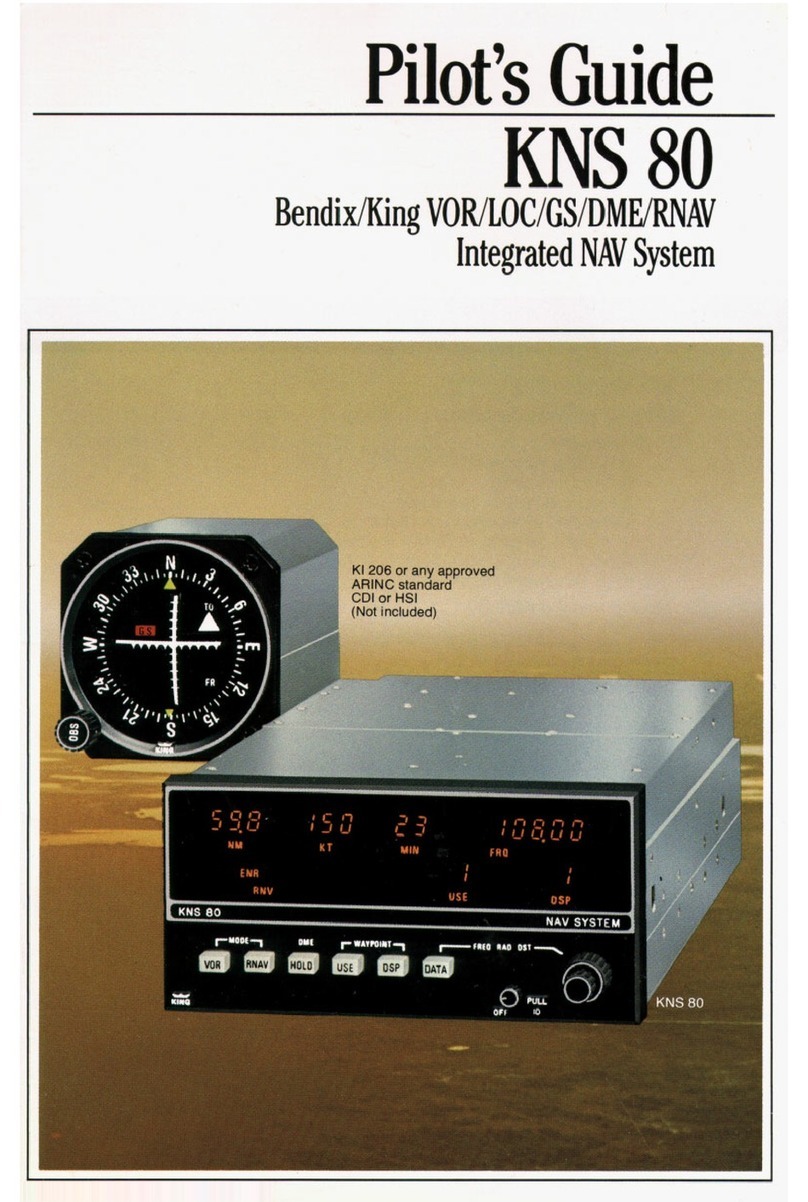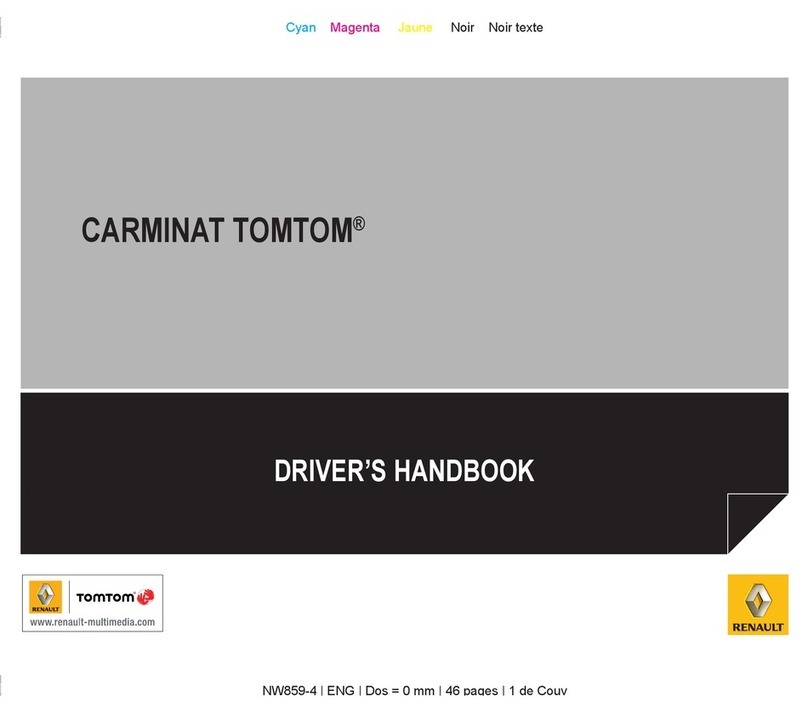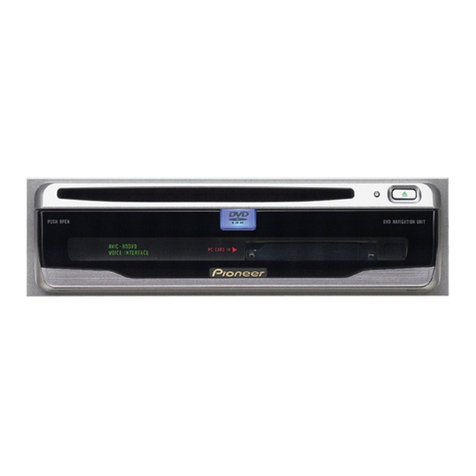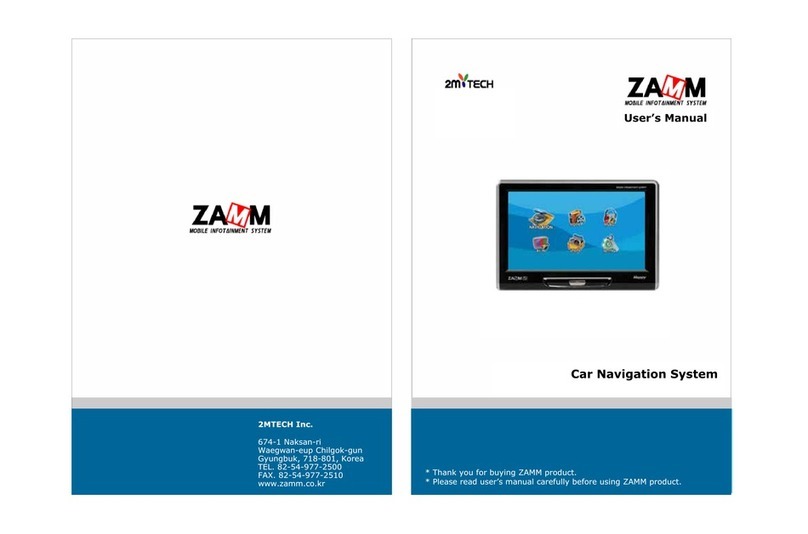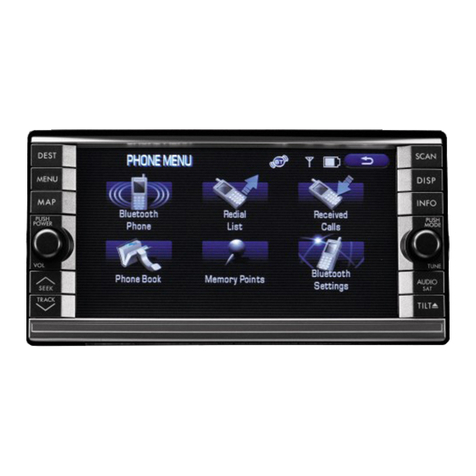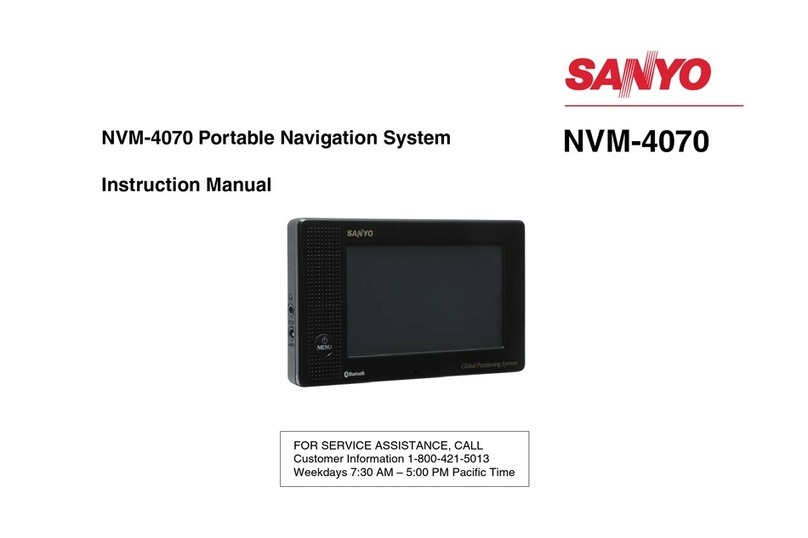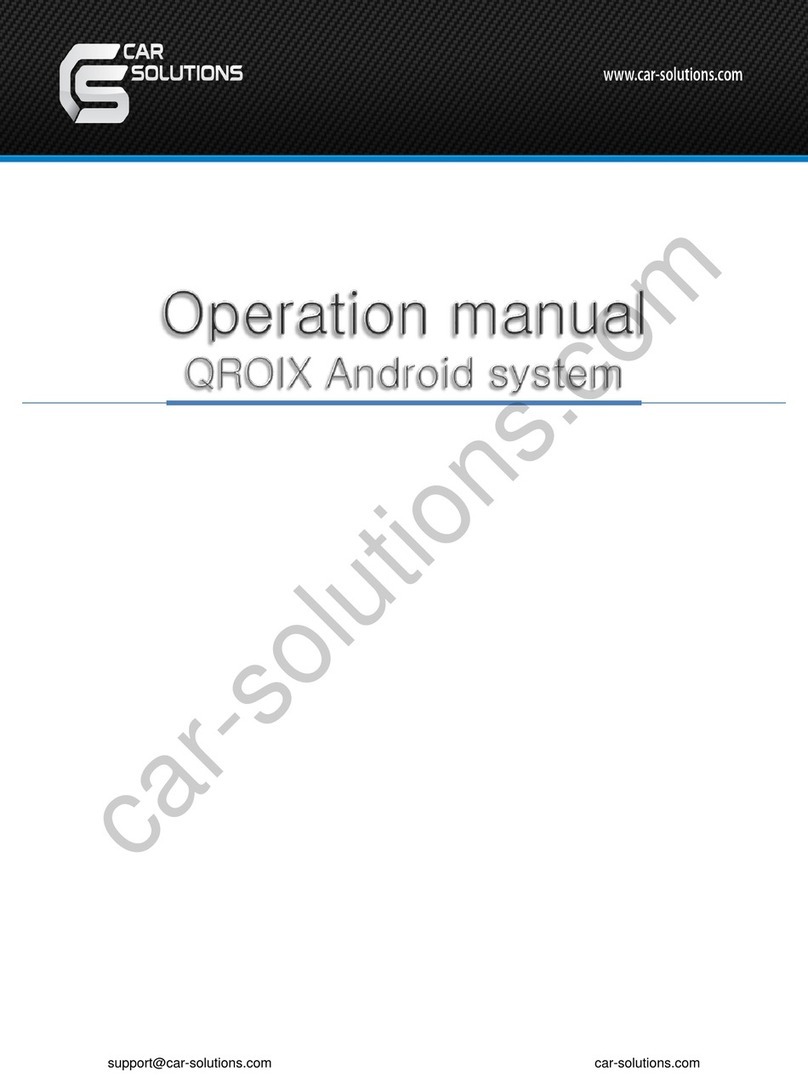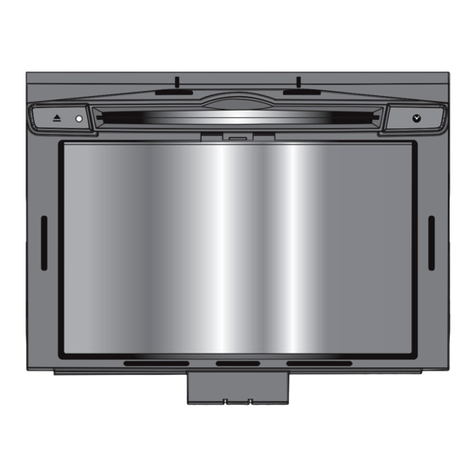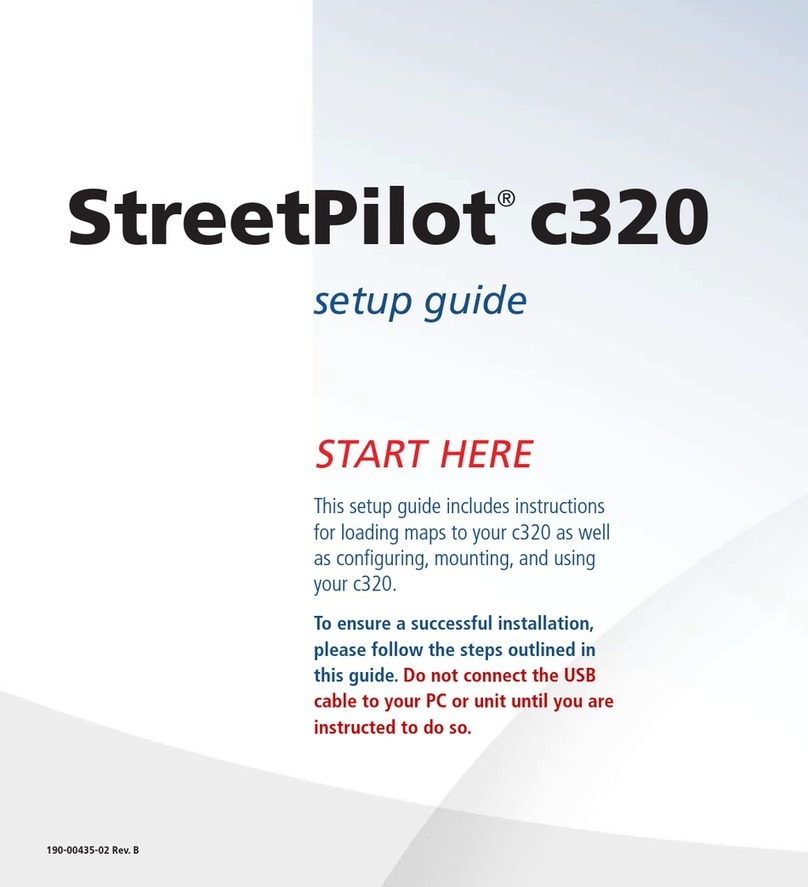BENDIXKing AeroNav 800 FMS/GPS/NAV/COM Manual

AeroNav 800 FMS/GPS/NAV/COM
AeroNav 780 FMS/GPS
Pilot’s Guide

BendixKing Technical Publications
Download or view publications online at www.bendixking.com
Questions about this publication can be emailed to: pubs@bendixking.com
BendixKing Customer Support
U.S.A. and Canada: 1-855-250-7027 (Toll Free)
International: 1-505-903-6148
www.bendixking.com
Email: techsupport@bendixking.com
www.avidyne.com/support/license.asp
BendixKing Part Number 89000041-008
Printed in the U.S.A. May 2019
This document contains technical data and is subject to U.S. export
regulations. These commodities, technology, or software were
exported from the United States in accordance with the export
administration regulations. Diversion contrary to U.S. law is prohibited.
ECCN: 7E994, NLR Eligible

AeroNav 800/780 Series Pilot’s Guide
89000041-008
Rev 1 May 2019 i
Record of Revision
REVISION
REVISION
DATE
DESCRIPTION
0
03MAY2019
Initial Release
1
14MAY2019
Updated revision number
Deleted Materials License
Agreement and copyright
information
Added a link to Avidyne
Software License Information

AeroNav 800/780 Series Pilot’s Guide
89000041-008
ii Rev 1 May 2019
Blank Page

AeroNav 800/780 Series Pilot’s Guide
89000041-008
Rev 1 May 2019 Table of Contents 1
TABLE OF CONTENTS
1System Overview...............................................................1-1
INTENDED FUNCTION.......................................................1-2
AeroNav 800....................................................................1-2
AeroNav 780....................................................................1-3
FUNCTIONAL OVERVIEW .................................................1-4
BASIC CONCEPTS.............................................................1-6
Page Function Keys.........................................................1-6
Line Select Keys..............................................................1-6
Right Knob Labeling.........................................................1-7
Color Philosophy..............................................................1-7
GENERAL AERONAV OPERATIONS ................................1-9
AeroNav 800 Bezel Layout..............................................1-9
AeroNav 780 Bezel Layout............................................1-10
Power Control ................................................................1-12
Brightness Controls........................................................1-13
Start-Up Sequence ........................................................1-14
Database Currency States.............................................1-17
Page Layout and Formats..............................................1-19
Com-Nav †.....................................................................1-21
Frequency List † ............................................................1-27
Transponder Control and Display..................................1-28
Direct-To Operations......................................................1-31
Function Keys ................................................................1-33
Touch Screen.................................................................1-35
Use of External Keyboard..............................................1-39
Dual AeroNav Operations..............................................1-40
WiFi (Network) Operations.............................................1-45
WAAS vs Non-WAAS Operations..................................1-48
Interaction With External Devices..................................1-49
Before Takeoff Techniques............................................1-50
2FMS Subsystem .................................................................2-1
FPL (FLIGHT PLAN) TAB....................................................2-2
FMS Basic Concepts .......................................................2-2
Creating a New Flight Plan..............................................2-4
Previewing Flight Plans....................................................2-6
Selecting a Departure ......................................................2-8
Inserting A Waypoint......................................................2-10
Inserting an Airway ........................................................2-11
Deleting A Waypoint ......................................................2-12

AeroNav 800/780 Series Pilot’s Guide
89000041-008
2 Table of Contents Rev 1 May 2019
Editing A Waypoint.........................................................2-13
Adding Altitude Constraints............................................2-13
Entering And Intercepting A Radial................................2-14
Deleting A Flight Plan ....................................................2-16
Creating A Holding Pattern............................................2-16
Circular Orbits................................................................2-18
Deleting A Holding Pattern.............................................2-19
Editing A Holding Pattern...............................................2-20
Activating a Flight Plan ..................................................2-20
Flight Plan Sequencing..................................................2-20
Lateral Offsets................................................................2-21
Flight Plan Discontinuities (Gaps)..................................2-22
Enroute Descents ..........................................................2-23
Entering An Arrival and Approach .................................2-26
Activating A Leg.............................................................2-30
Use of the Map FPL Split Page .....................................2-30
INFO TAB ..........................................................................2-32
ROUTE TAB ......................................................................2-36
Creating A New Route...................................................2-37
Editing a Route ..............................................................2-37
Naming A Route.............................................................2-37
Copying A Route............................................................2-38
Inverting A Route ...........................................................2-39
Activating A Route .........................................................2-40
Deleting A Route............................................................2-40
WPT (USER WAYPOINTS) TAB.......................................2-42
Creating A User Waypoint .............................................2-42
Naming A User Waypoint...............................................2-43
Deleting A User Waypoint..............................................2-43
Designating A User Waypoint As An Airfield.................2-43
NRST (NEAREST) TAB.....................................................2-45
3Map Subsystem..................................................................3-1
MAP TAB .............................................................................3-2
Map Controls....................................................................3-2
Other Map Features.........................................................3-5
Fuel Range RingS..........................................................3-10
Decluttering The Map.....................................................3-11
Map Panning..................................................................3-12
Graphical Flight Planning (“Rubber Banding”)...............3-13
Altitude Constraints On Map..........................................3-14
Map Information Pop-Up Boxes.....................................3-15
Datalink Weather Overlays And Operations..................3-17
Datalink Radar ...............................................................3-18

AeroNav 800/780 Series Pilot’s Guide
89000041-008
Rev 1 May 2019 Table of Contents 3
Weather Overlays On Map ............................................3-20
TFRs ..............................................................................3-24
Indications Of Data Age.................................................3-25
Weather Radar Selection For Map Overlay...................3-26
Terrain............................................................................3-27
TERRAIN AWARENESS (TA).......................................3-28
Forward Looking Terrain Alerting (FLTA) ......................3-29
500’ Callout ....................................................................3-32
TERRAIN ALERTING WARNING SYSTEM (TAWS)........3-33
Premature Descent Alert (PDA).....................................3-36
Excessive Descent Rate (EDR).....................................3-37
Negative Climb Rate / Altitude Lost After Takeoff .........3-38
TAWS Inhibit Control .....................................................3-40
TAWS Self-Test.............................................................3-40
Degraded Or No TAWS Conditions...............................3-40
Traffic Display ................................................................3-41
SYNTHETIC VISION (SVS) TAB.......................................3-50
RADAR TAB ......................................................................3-55
4Aux Subsystem..................................................................4-1
AUDIO TAB..........................................................................4-2
Volume Control ................................................................4-2
Satellite Radio Tuning......................................................4-4
Com Presets † .................................................................4-6
UTIL (UTILITIES) TAB.........................................................4-8
Timers..............................................................................4-8
Calculators.....................................................................4-11
Electronic Checklist........................................................4-15
SETUP TAB.......................................................................4-19
Datablock Setup.............................................................4-19
Map Setup......................................................................4-39
FMS Setup.....................................................................4-40
User Options..................................................................4-40
SYS (SYSTEM) TAB..........................................................4-63
Fuel Management..........................................................4-63
System Status................................................................4-63
ALERT TAB .......................................................................4-74
5Navigation...........................................................................5-1
NAV SOURCE KNOB/BUTTON..........................................5-6
OBS MODE........................................................................5-10
VOR COURSE DEPICTION † ...........................................5-13
ARMED VS ENGAGED/ACTIVE INDICATIONS...............5-14
FMS HOOKS .....................................................................5-15

AeroNav 800/780 Series Pilot’s Guide
89000041-008
4 Table of Contents Rev 1 May 2019
COURSE CHANGES AND HOLDS...................................5-18
AUTO VLOC TUNING † ....................................................5-19
TRANSITION ALTITUDES/LEVELS..................................5-20
NAVIGATION MODE/CDI SCALE CHANGING ................5-22
APPROACH PROCEDURES ............................................5-24
Automatic mode switching † ..........................................5-25
Precision Approaches....................................................5-26
Non-Precision Approaches............................................5-27
Back Course Approaches † ...........................................5-27
WAAS Approaches........................................................5-28
MISSED APPROACH........................................................5-32
RETRY APPROACH..........................................................5-35
RNP/RNAV OPERATIONS................................................5-37
RECOMMENDED ICAO EQUIPMENT CODES................5-38
6General................................................................................6-1
CAUTION ADVISORY SYSTEM (CAS) / ALERTS.............6-2
Master Caution Lamps.....................................................6-2
Warning-Caution-Advisory Message Bar.........................6-3
SELF TEST OUTPUT........................................................6-26
SYSTEM FAILURES..........................................................6-27
Power Distribution..........................................................6-27
Loss Of AeroNav............................................................6-27
Loss Of Display..............................................................6-28
Loss Of Bezel Controls..................................................6-29
Loss Of Touchscreen Control........................................6-29
Loss Of GPS (Dead Reckoning)....................................6-30
Other Anomalies ............................................................6-31
SUBSCRIPTIONS..............................................................6-32
NIGHT OPERATIONS.......................................................6-33
AeroNav DISPLAY BRIGHTNESS ................................6-33
AeroNav Bezel Brightness.............................................6-33
Charts Lighting Scheme.................................................6-33
Display Of Terrain On Map............................................6-34
HIGH TEMPERATURE OPERATIONS.............................6-35
COLD TEMPERATURE OPERATIONS............................6-36
LOW POWER OPERATIONS ...........................................6-37
HIGH POWER OPERATIONS...........................................6-39
USE OF GLOVES..............................................................6-40
CHARGING FROM THE USB...........................................6-42
INTEGRATION WITH THE IFD100 MOBILE APP............6-43
DEMO MODE ....................................................................6-44
DATA TRANSFER TO/FROM EXTERNAL DEVICES......6-47
REGULATORY COMPLIANCE STATEMENTS................6-51

AeroNav 800/780 Series Pilot’s Guide
89000041-008
Rev 1 May 2019 Table of Contents 5
Radio Regulatory Compliance Statements†..................6-51
Déclaration(s) de conformité réglementaire†.................6-52
MAINTENANCE MODE.....................................................6-53
Starting Maintenance Mode at power up.......................6-53
Starting Maintenance Mode from Flight Mode...............6-53
Exiting Maintenance Mode.............................................6-55
DATABASE UPDATES......................................................6-56
SOFTWARE UPDATES ....................................................6-63
DATALOGS DOWNLOAD.................................................6-64
USER DATA BACKUP/RESTORATION PROCEDURE...6-69
Saving User Data...........................................................6-69
Reloading Previously Stored User Data ........................6-70
CONFIGURING WIFI.........................................................6-71
Defining WIFI network configurations............................6-71
selecting a network configuration ..................................6-74
CONFIGURING WIRED ETHERNET................................6-75
Configuring as a Network server ...................................6-75
Configuring as a Network client.....................................6-75
Configuring as a client with a static IP...........................6-75
PAIRING A BLUETOOTH®KEYBOARD...........................6-77
Verification of successful pairing ...................................6-80
CLEANING THE DISPLAY................................................6-83
SLIDE-IN REPLACEMENT DETAILS................................6-84

AeroNav 800/780 Series Pilot’s Guide
89000041-008
6 Table of Contents Rev 1 May 2019
Blank Page

AeroNav 800/780 Series Pilot’s Guide
89000041-008
Rev 1 May 2019 System Overview 1-1
1 System Overview
This manual assumes that the pilot is appropriately licensed, is
proficient in operation of the aircraft and its equipment, and is in
compliance with all Federal Aviation Regulations (FARs).
All images contained in this manual are for reference use only,
and are subject to change.
BendixKing strongly recommends that pilots use the AeroNav
system only under VFR conditions until completely familiar with
its operation and use.
Boxed areas marked as NOTE within this manual identify certain
situations or areas of operation having heightened safety
implications. While it is important for the operator to be familiar
with all of the information in the manual, it is essential to the safe
use of the AeroNav that pilots give careful attention to the
material contained within these NOTEs.
In order to avoid a diversion of attention from the task of safely
taxiing, pilots should avoid performing the described cockpit tasks
while the aircraft is in motion on the ground. It remains the pilot’s
duty to monitor the AeroNav for proper function upon activation
and during use.
Internal data logs and the storage devices that record and store
data are property of BendixKing.

AeroNav 800/780 Series Pilot’s Guide
89000041-008
1-2 System Overview Rev 1 May 2019
INTENDED FUNCTION
This manual describes operation of the AeroNav 8xx series of
equipment. Not all capabilities described herein are applicable to
every model in the series. The AeroNav 800 is the basis for
capabilities described in the manual. Differences from the
AeroNav 800 are specifically identified throughout the manual.
AERONAV 800
The BendixKing AeroNav 800 is a GPS-Nav-Com radio whose
primary function is to conduct nav-com-transponder tuning and
communication, and serve as the principal navigation
sensor/system for all IFR VHF (“VLOC”) and GPS-based
navigation and instrument flying (enroute and approach),
provided it is connected to an external navigation source
selection annunciator and a CDI/HSI indicator that is installed in
the required field of view.
AeroNav 800 Integrated Flight Display
Supplemental AeroNav 800 functions include a moving-map,
flight management system (FMS), checklists, and a number of
timer and calculator types of utilities. The system includes terrain
alerting as well as an option for TAWS. An option is also available
that will give the AeroNav 800 the ability to control and display
weather radar.

AeroNav 800/780 Series Pilot’s Guide
89000041-008
Rev 1 May 2019 System Overview 1-3
AERONAV 780
The BendixKing AeroNav 780 differs from the AeroNav 800 in
that there is no internal VHF nav/com radio. Its primary function
is to conduct GPS-based navigation in an IFR environment,
provided it is connected to an external navigation source
selection annunciator and CDI/HSI indicator that is installed in the
required field of view. The AeroNav 780 cannot be used to
execute terminal area procedures that rely on radio navigation.
The AeroNav 780 bezel differs physically from the AeroNav 800
in that the radio controls along the left side of the bezel are
absent, the nav source selection knob is replaced by an OBS
button, and the volume knob is replaced by a single-function
on/off button.
AeroNav 780 Integrated Flight Display
Supplemental AeroNav 780 functions include a moving-map,
flight management system (FMS), checklists, and a number of
timer and calculator types of utilities. The system includes terrain
alerting as well as an option for TAWS. An option is also available
that will give the AeroNav 780 the ability to control and display
weather radar.
DOCUMENTATION CONVENTION
Throughout this document, capabilities that are
not applicable to the AeroNav 780 are identified
using a † symbol.

AeroNav 800/780 Series Pilot’s Guide
89000041-008
1-4 System Overview Rev 1 May 2019
FUNCTIONAL OVERVIEW
The BendixKing AeroNav system supports the following
functions:
Flight Management System (FMS)
WAAS and non-WAAS GPS Navigation
VHF Radio Nav/Com (16W and 10W variants) †
Moving Map including synthetic vision view
Terrain Awareness
Forward Looking Terrain Alerting (FLTA)
Terrain Alerting Warning System (TAWS) [optional]
Weather Datalink
ADS-B position and display
Lightning sensor depictions
Weather radar [optional]
Traffic
Electronic Checklists
Data Logging
Caution Advisory System (CAS)
Utilities (e.g. Schedulers, Timers, Calculators)
Multi-touch Touch screen Control
Multiple AeroNav Operations
Remote Transponder Control and Display
WiFi and Bluetooth®Communication [optional]
COOL FEATURE
Multi-Touch Touch Screen Control
The AeroNav supports multi-touch touch screen
technology meaning that features such as two-
fingered pinch zoom for range changing on maps
and charts is fully enabled.
The system has been designed for single-pilot IFR operation and
features a Page and Tab user interface.

AeroNav 800/780 Series Pilot’s Guide
89000041-008
Rev 1 May 2019 System Overview 1-5
Most functions revolve around the Page Function Keys that
appear across the bottom edge of the bezel. Each of the three
functional pages has associated tabs, which contain related data,
often in different views. These functions and tabs are covered in
detail throughout this reference manual.

AeroNav 800/780 Series Pilot’s Guide
89000041-008
1-6 System Overview Rev 1 May 2019
BASIC CONCEPTS
PAGE FUNCTION KEYS
The buttons along the bottom of the AeroNav bezel are called
Page Function Keys. Each key is labeled by function:
FMS (Flight Management System)
MAP (Moving Map)
AUX (System Pages)
Each page has a number of associated tabs. Each Page Function
key has a left and right rocker nature to it. Select the page of
interest by pressing the middle of the Page Function Key and
navigate through the available tabs by pressing the left or right
side of the Page Function Key. Continual pressing of one side of
the function key will automatically step through the tabs.
Page Function Keys and Tabs
LINE SELECT KEYS
Line Select Keys (LSK), are the buttons found along the left
vertical side of the bezel. These are different from Page Function
Keys in that they also have a label, just inside the bezel adjacent
to the physical button, which indicates the function of the LSK.
An LSK can either represent an action or a state.
A State LSK is identified by a title on the first row, shown in blue-
green, and the current state on the second row shown in white.
The title reflects the system function or setting to be affected, and
the state shows the current state of that setting. Pressing the
LSK or touching the label will change to the next state.
An Action LSK is identified by a phrase shown in blue-green.
The phrase is usually in verb-subject form, but there are
exceptions when the verb is omitted (e.g. "User Options").
Pressing the LSK or touching the label will cause the system to
perform the specified action.

AeroNav 800/780 Series Pilot’s Guide
89000041-008
Rev 1 May 2019 System Overview 1-7
LSK Types
RIGHT KNOB LABELING
The bottom right AeroNav knob is context-sensitive. Displayed in
the lower right corner of the display, the knob label indicates the
function of the knobs and the knob button on the left and right
side, respectively. As a general rule, the inner and outer rings of
the dual concentric knob perform the same function. Typically,
the inner ring is “fine” control and the outer ring is “coarse” control
for the function. The symbol used to represent the knob button is
a ring with a center dot.
Right Knob Label Scheme
In the example above, the outer ring scrolls through a list in a
coarse manner and the inner ring scrolls through the same list
stopping at each minor field along the way. Pushing the knob
generates a drop-down menu.
COLOR PHILOSOPHY
There are a few generalities with the use of color that are
consistent across the AeroNav as described in the table below:

AeroNav 800/780 Series Pilot’s Guide
89000041-008
1-8 System Overview Rev 1 May 2019
AeroNav Feature/Function
Color
Page Function Keys
Green - Active
White - Available but not
currently active
Note: AUX can also be Red,
Yellow, or Cyan if there is an
active alert as described
later in this manual
FMS “Fly To” Data (e.g. active
leg of flight plan, To Waypoint
datablock)
Magenta
Active Nav Data (e.g. Active
Com freq, Active Nav freq,
Active Nav Source mode)
Green
Line Select Key Labels
Light Blue-Green
Line Select Key States
White

AeroNav 800/780 Series Pilot’s Guide
89000041-008
Rev 1 May 2019 System Overview 1-9
GENERAL AERONAV OPERATIONS
The AeroNav is a touch screen unit that has been designed for
compatibility with both retrofit and clean installations. As a retrofit
installation, the AeroNav 800 was designed to be a slide-in
replacement for a Garmin 430/W unit. Similarly, the AeroNav 780
was designed to be a slide-in replacement for a Garmin 400/W
unit.
AERONAV 800 BEZEL LAYOUT
Com/Nav Manual
TuningKnob PageFunction
Keys
CamLatch
LineSelectKeys
Dedicated
FunctionKeys
Context
SensitiveKnob
Volume/Power /
Squelch Knob CDINav
SourceKnob AmbientLight
Sensor
Frequency
Swap
USBPort

AeroNav 800/780 Series Pilot’s Guide
89000041-008
1-10 System Overview Rev 1 May 2019
AERONAV 780 BEZEL LAYOUT
Starting in the top left corner and working counter-clockwise
around the bezel, the AeroNav has:
Power/Volume/Squelch knob †
Power button*
Frequency Swap dedicated button †
Three (3) Line Select Keys (LSKs) that are page
dependent with soft key labels adjacent to each
Dual Concentric Rotary Knob as a means of manually
tuning Com and Nav frequencies †
Mechanical Cam Latch control for tray installation
Page Function keys along the bottom
USB port for database updates, datalog downloads,
software updates and powering USB devices in-flight
Dual Concentric Rotary Knob that is page dependent
Four (4) Dedicated Function Keys consisting of:
oDirect-To (“─D─>”)
oProcedure (“PROC”)
oEnter (“ENTR”)
oClear (“CLR”)
This manual suits for next models
1
Table of contents
Other BENDIXKing Car Navigation System manuals
